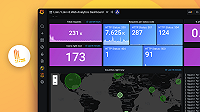Important: This documentation is about an older version. It's relevant only to the release noted, many of the features and functions have been updated or replaced. Please view the current version.
Kubernetes Query Frontend Example
Disclaimer
This aims to be a general purpose example; there are a number of substitutions to make for it to work correctly. These variables take the form of <variable_name>. You should override them with specifics to your environment.
Use case
It’s a common occurrence to start running Grafana Loki as a single binary while trying it out in order to simplify deployments and defer learning the (initially unnecessary) nitty gritty details. As we become more comfortable with its paradigms and begin migrating towards a more production ready deployment there are a number of things to be aware of. A common bottleneck is on the read path: queries that executed effortlessly on small data sets may churn to a halt on larger ones. Sometimes we can solve this with more queriers. However, that doesn’t help when our queries are too large for a single querier to execute. Then we need the query frontend.
Parallelization
One of the most important functions of the query frontend is the ability to split larger queries into smaller ones, execute them in parallel, and stitch the results back together. How often it splits them is determined by the querier.split-queries-by-interval flag or the yaml config queryrange.split_queriers_by_interval. With this set to 1h, the frontend will dissect a day long query into 24 one hour queries, distribute them to the queriers, and collect the results. This is immensely helpful in production environments as it not only allows us to perform larger queries via aggregation, but also evens the work distribution across queriers so that one or two are not stuck with impossibly large queries while others are left idle.
Kubernetes Deployment
ConfigMap
Use this ConfigMap to get the benefits of query parallelisation and caching with the query-frontend component.
apiVersion: v1
kind: ConfigMap
metadata:
name: loki-frontend
namespace: <namespace>
data:
config.yaml: |
# Disable the requirement that every request to Cortex has a
# X-Scope-OrgID header. `fake` will be substituted in instead.
auth_enabled: false
# We don't want the usual /api/prom prefix.
http_prefix:
server:
http_listen_port: 3100
query_range:
# make queries more cache-able by aligning them with their step intervals
align_queries_with_step: true
max_retries: 5
# parallelize queries in 15min intervals
split_queries_by_interval: 15m
cache_results: true
results_cache:
cache:
# We're going to use the in-process "FIFO" cache
enable_fifocache: true
fifocache:
size: 1024
validity: 24h
limits_config:
max_cache_freshness_per_query: '10m'
frontend:
log_queries_longer_than: 5s
downstream_url: http://querier.<namespace>.svc.cluster.local:3100
compress_responses: trueFrontend Service
apiVersion: v1
kind: Service
metadata:
annotations:
labels:
name: query-frontend
name: query-frontend
namespace: <namespace>
spec:
ports:
- name: query-frontend-http
port: 3100
protocol: TCP
targetPort: 3100
selector:
name: query-frontend
sessionAffinity: None
type: ClusterIP
ClusterIP: None
publishNotReadyAddresses: trueFrontend Deployment
apiVersion: extensions/v1beta1
kind: Deployment
metadata:
labels:
name: query-frontend
name: query-frontend
namespace: <namespace>
spec:
minReadySeconds: 10
replicas: 2
selector:
matchLabels:
name: query-frontend
template:
metadata:
labels:
name: query-frontend
spec:
containers:
- args:
- -config.file=/etc/loki/config.yaml
- -log.level=debug
- -target=query-frontend
image: grafana/loki:latest
imagePullPolicy: Always
name: query-frontend
ports:
- containerPort: 3100
name: http
protocol: TCP
resources:
limits:
memory: 1200Mi
requests:
cpu: "2"
memory: 600Mi
volumeMounts:
- mountPath: /etc/loki
name: loki-frontend
restartPolicy: Always
terminationGracePeriodSeconds: 30
volumes:
- configMap:
defaultMode: 420
name: loki-frontend
name: loki-frontendGrafana
Once you’ve deployed these, point your Grafana datasource to the new frontend service. The service is available within the cluster at http://query-frontend.<namespace>.svc.cluster.local:3100.
GRPC Mode (Pull model)
The query frontend operates in one of two ways:
Specify
--frontend.downstream-urlor its YAML equivalent,frontend.downstream_url. This proxies requests over HTTP to the specified URL.Without
--frontend.downstream-urlor its yaml equivalentfrontend.downstream_url, the query frontend defaults to a pull service. As a pull service, the frontend instantiates per-tenant queues that downstream queriers pull queries from via GRPC. To act as a pull service, queriers need to specify-querier.frontend-addressor its YAML equivalentfrontend_worker.frontend_address.Set
ClusterIP=Nonefor the query frontend pull service. This causes DNS resolution of each query frontend pod IP address. It avoids wrongly resolving to the service IP.Enable
publishNotReadyAddresses=trueon the query frontend pull service. Doing so eliminates a race condition in which the query frontend address is needed before the query frontend becomes ready when at least one querier connects.



